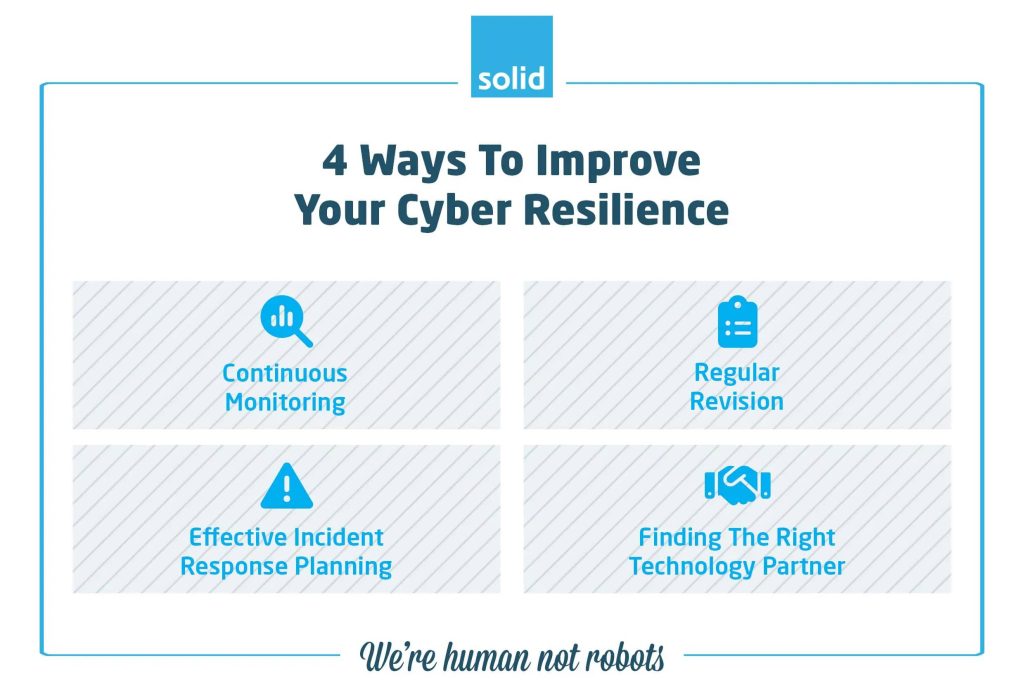
In today’s digital world, the threat of cyber attacks is constantly growing. As businesses are relying more than ever before on technology for their daily operations, they become more vulnerable to data breaches, ransomware attacks, social engineering attacks, and even human error. Cyber threats are becoming not only more common, but more sophisticated as well, making it difficult for businesses to recognise when an attack is taking place. The risk to your operations is stark – a single attack can see work grinding to a halt, cost your company millions, and have a severe impact on your reputation.
This is why more and more businesses are seeing the need for cyber resilience.
What Is Cyber Resilience?
Cyber resilience is the process of building and maintaining a strong defence against cyber threats, while also having the ability to quickly bounce back if an attack does happen. It’s all about being able to prepare for, respond to, and recover from a cyber attack, and it involves implementing strategies and measures that not only stop attacks from taking place, but also ensure minimal impact on business operations and reputation if one does occur.
Why Is Cyber Resilience More Important Than Ever?
Now that we understand what cyber resilience is, let’s take a look at why it’s growing in popularity.
As businesses around the world are going through digital transformation – embracing emerging technologies and putting them to the best use to increase productivity, accessibility and security – cyberattackers are using sophisticated techniques to gain access to data and compromise it, leak it, or hold it ransom. Businesses are finding it necessary to implement strategies to combat these attacks. With the right cyber resilience policies in place, your company can:
• Reduce The Risk Of Data Loss
Data is the most valuable asset for any business, and it’s also the main target of cyber criminals. Implementing a cyber resilience strategy can help you to reduce the risk of data loss by implementing measures like regular and automated Office 365 backup, strong encryption, and secure storage.
• Ensure Faster Recovery And Improve Business Continuity
Business continuity is key to the survival of any business. Keeping your data, apps and systems available at all times is crucial to keeping your company running day in and day out. But even with the best prevention measures in place, it’s still possible for a cyber attack to occur. Having a solid cyber resilience plan in place means that you’ll be able to recover from the attack far quicker. With a Disaster Recovery Plan (DRP) in place which guides your humans on how to respond to attacks, and backups of your data ready to restore, you can ensure that your operations never grind to a halt, even if an attack does happen.
• Mitigate Financial Loss
The costs associated with a cyber attack can be significant – from financial loss due to downtime and data loss, to reputational damage and legal fees. By implementing a cyber resilience strategy, you can mitigate these costs by being prepared for an attack, minimising the impact of any downtime and data loss through faster recovery, reducing the risk of critical data being leaked to the public thanks to encryption, and avoiding penalties under regulations like South Africa’s POPI Act and the EU’s GDPR.
• Maintain Your Reputation
Reputation is everything in business. A cyber attack can not only result in financial loss, but also damage the trust and confidence of your customers and partners. By having a solid cyber resilience plan in place, you can minimise the impact on your business’ reputation, since the downtime that your customers will experience will be minimal, their data is at less risk of becoming compromised, and their sensitive information will stay secure. On top of this, having a communication plan as part of your cyber resilience strategy can ensure that you keep stakeholders and clients informed in the right way without causing panic, which can in turn actually boost your reputation when they realise that their data is secure with your business.
What Is The Difference Between Cyber Resilience And Disaster Recovery Planning?
While both cyber resilience and disaster recovery focus on mitigating the impact of a security breach, there are key differences between the two. Disaster recovery planning is much broader in spectrum, taking into account more than just cyberattacks, but natural disasters, infrastructure breakdown and human error as well. Cyber resilience, on the other hand, focuses in on cyber threats specifically and how to prepare for them, react to them, and prevent them from happening in the first place.
Cyber resilience should definitely form part of your larger Disaster Recovery Plan, since a DRP that doesn’t take cyberattacks into account will not be effective in today’s modern world, but it can almost be seen as a subset to a larger security planning strategy.
How Does Cyber Resilience Work?
Cyber resilience works by implementing a multi-layered approach to security. This includes measures like firewalls, encryption, regular cloud backups, and employee training. By implementing these measures, you are creating multiple barriers to protect your data and systems from cyberattacks. In the event that a breach does occur, having a strong incident response plan in place can help you quickly identify the issue, contain it, and recover your systems and data as quickly as possible.
What Are The Challenges Of Cyber Resiliency?
While cyber resilience is essential in today’s digital landscape, there are still challenges that your business may face when implementing it into your security strategy. These challenges can be broken up into three broad categories: on-premises challenges, cloud challenges, and human challenges.
• On-Premises Challenges
If you have your own physical IT infrastructure, maintaining cyber resilience can be especially difficult. There is a misconception on-premises infrastructure is safer, since less people are able to access your systems with them being located on your property. But you need to make sure that you are staying up to date with security patches and keeping hardware and software up to date. On top of that, you need to ensure that your networks are protected from physical threats, such as power outages or natural disasters. The fact is that your infrastructure is only as protected as it’s latest update, and updating and maintaining on-premises solutions is much more difficult than their cloud counterparts because they are more difficult to access.
• Cloud Challenges
With the rise of cloud computing, many businesses have moved their data and systems to the cloud. While this can provide numerous benefits, both in terms of flexibility, affordability and security in general, it can also introduce new challenges for maintaining cyber resilience. One of the main challenges is data security. While cloud services are more accessible, making them easier to maintain, risks can be introduced when using a shared public cloud environment which is accessed by multiple companies, and there is the risk of potential downtime or service interruptions if your cloud provider themselves is undergoing maintenance. This is why many businesses are taking a multi-cloud approach to their cloud computing needs, storing data that is critical to their operations on more expensive private cloud infrastructure, while making use of public cloud for their less critical processes.
• Human Challenges
One often overlooked aspect of cyber resilience is the human factor. Despite the advancements in technology and security measures, it is ultimately humans who are responsible for maintaining your cybersecurity. One of the biggest challenges your business is likely to face in implementing your security strategy is ensuring that your team members are educated and trained in cybersecurity best practices. This includes everything from password management to identifying phishing scams or social engineering attacks. And even with proper training and protocols in place, human error is still going to be common. This is why you also need to have contingency plans and effective incident response procedures in place for when mistakes happen. This is even more important with the rise of remote work, since your humans are often going to be using their own personal devices to access company data and systems, emphasising the need for proper training and communication.
What Components Should Be Included In Your Cyber Resilience Strategy?
When developing your cyber resilience strategy, there are several key components that need to be considered in order to ensure its effectiveness. These include tools, roles, communication and training.
• Tools
The right tools are necessary for implementing an effective cyber resilience plan. This includes a combination of hardware and software solutions, from Microsoft 365 security platforms like Defender and Intune, to firewalls, Identity and Access Management, encryption software and antivirus programs. These tools help to prevent, detect and mitigate cyber attacks.
• Roles
It is important to assign specific roles and responsibilities within your team for maintaining cyber resilience. This includes designating a team leader or manager who oversees the overall strategy, as well as assigning tasks such as regular backups and system updates to specific individuals. It’s important that every one of your team members understands the role that they play in not only preventing cyberattacks, but in recognising potential attacks and reacting to them in the right way.
• Communication
Communication is key in any successful business, and it is especially important when it comes to cyber resilience. This includes regular communication between team members to ensure everyone is aware of potential threats and protocols for responding to them. It also involves open lines of communication with any third-party vendors or partners who may have access to your systems or data, and strategies for what to tell your stakeholders and clients if an attack does occur. Focusing on transparency and reassurance will be critical in making sure that the negative impact on your reputation is as minimal as possible.
• Training
As mentioned earlier, proper training is crucial for maintaining cyber resilience. It’s important to regularly train your team on the latest threats and how to identify them, as well as best practices for preventing attacks. This can include simulated attack scenarios, regular phishing training, and staying up-to-date with industry news and trends.
4 Ways To Improve Your Cyber Resilience

Now that we’ve covered the essentials of a robust cyber resilience strategy, let’s delve into some key ways to bolster your defences. In this section, we will explore four proactive measures that can significantly elevate your business’ resilience against cyber threats. Implementing these strategies effectively can protect your business from potential security breaches, minimise disruption in the event of an attack, and ensure a quick recovery to maintain business continuity.
1. Continuous Monitoring
Implementing continuous monitoring of your systems and network can help identify any potential vulnerabilities or attacks in real-time. This allows for a quick response, potentially even cutting off the attacker in their tracks, and minimises the impact of an attack.
2. Regular Revision
Cyber threats are constantly evolving, so it’s important to regularly review and update your cyber resilience strategy. This should include reviewing and updating security measures, training protocols, and communication strategies on a regular basis. It could also include putting some of the latest security tools in place, from Artificial Intelligence and machine learning, to firewalls and encryption, to Multi-Factor Authentication and regular, automated backups of critical information.
3. Effective Incident Response Planning
In the event of a cyber attack, having an effective incident response plan in place is crucial for minimising damage and ensuring a swift recovery. This should include clear steps for identifying and containing the attack, as well as communication protocols to keep all stakeholders, team members, and clients informed.
4. Finding The Right Technology Partner
So many companies think that they have to take on the challenges of cyber resilience and disaster recovery planning all on their own. They spend all their time and effort on the hunt for specialised professionals to form part of their own internal IT teams, when they could be outsourcing their cybersecurity needs to experts in the field.
Finding the right technology partner whose culture and goals are a good fit for your business’ needs can make all the difference. They can help you to put a cyber resilience strategy in place that will not only keep your company secure, but give you peace of mind knowing that your security is in good hands.
Is Solid Systems The Right Technology Partner For Your Business?
I’m not going to pretend that every business is perfectly suited to working with Solid Systems. Sometimes there just isn’t the right fit. But I can tell you that we’ve spent the past two decades working with companies around the world to grow their businesses and keep their data secure against threats.
When you work with Solid Systems, we go the extra mile to not only offer troubleshooting and an IT helpdesk, but to support your business from start to finish. This is why the first step we take is to get a good understanding of who you are as a company, what your goals are, and how technology and security fit into your plans for the future. From there, we work with you to create a disaster recovery and cyber resilience strategy that forms part of a larger strategic technology roadmap, and sees you adopting the right solutions, putting them to the best possible use, and increasing adoption throughout your business through training your teams in how to use the tools at their fingertips, how to recognise cyberattacks, and how to react to them.
If you’re a business with 20 or more users, if you’re looking for a technology partner or a Microsoft or cloud provider, if you want more from your technologies, then schedule your free consultation with our Sales team today, and let’s find ways to strengthen your cyber resilience and tackle the challenges of the modern workplace head-on.
Frequently Asked Questions
Cyber resilience refers to an company’s ability to prepare for, respond to, and recover from cyber threats or attacks. It’s your defensive shield against cybercrime, enabling you to continue your operations even amidst disruptive cyber incidents. Cyber resilience not only covers prevention measures, but also a robust recovery strategy to bounce back after a cyber-attack, minimising disruption to business operations and reducing any potential damage.
Cyber resilience is a subset of disaster recovery, focused on cyber threats in particular. It’s about preparing for, responding to and recovering from cyberattacks. Disaster Recovery, on the other hand, is a broader concept that encompasses not just cyberattacks, but all threats to your business continuity, including natural disasters, infrastructure failure and even human error.
Becoming cyber resilient involves developing a comprehensive strategy that includes continuous monitoring and updating of systems, establishing an effective incident response plan, implementing robust security measures, and choosing the right technology partner. Regularly revising and testing this strategy ensures your business is prepared against cyber threats. Crucially, training staff to recognise and respond to potential attacks is vital in fortifying your cyber resilience.
Managing cyber resilience isn’t a once-off effort – it’s a process that needs to be intricately managed, reviewed and revised to adapt to evolving cyber threats. A good place to start is understanding the threats that face your business, establishing a plan for responding to them, putting measures in place to secure your operations, your data, and your users, and making sure that your team members understand the roles that they have to play in keeping your company safe.
Popular Searches
- Cloud Storage Vs Cloud Backup
- IT Company in Midrand
- Components & Advantages of IT Infrastructure
- Tools in Microsoft 365
- Disaster Recovery Plans
- IT Company in Gauteng
- Preventing Cyber Attacks
- Advantages of Cloud Infrastructure
- IT Support in Centurion
- Data Security & Integrity
- IT Company in Durban
- Cloud Access Security Broker
- IT Company in Pretoria
- Types of Cyber Attacks
- Cyber Security Do's & Don'ts
- IT Company in Polokwane
- Data Breach
- Cybersecurity Tips For Employees
- IT Support in Sandton





